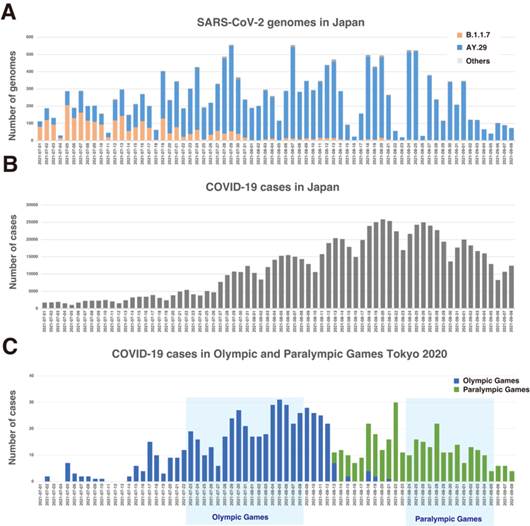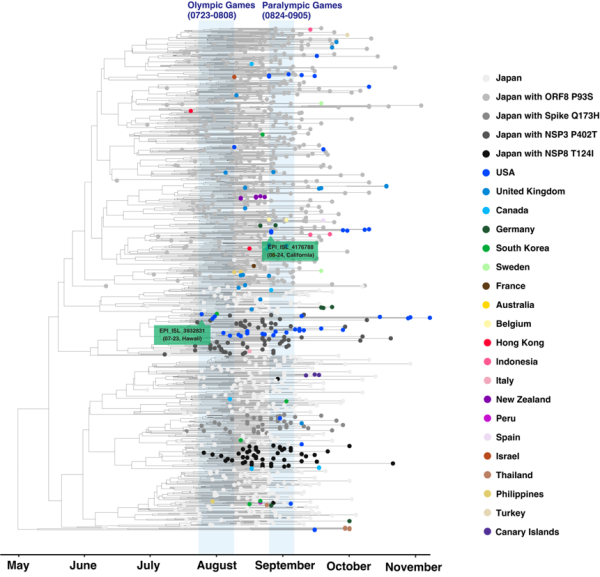Key Points of Presentation
・Human Genome Center, The Institute of Medical Science, The University of Tokyo (Director: Seiya Imoto) uncovered cross-border transmissions of the Delta substrain AY.29 from Japan to the world during Tokyo Olympic and Paralympic Games.・By using NCBI*1 and GISAID*2 genomes, the Delta substrain AY.29, which evolved in Japan before the Olympic and Paralympic Games in the summer of 2021, has been identified in 20 countries and regions, identifying at least 55 independent strains transmitted to overseas.
・Scientifically understanding how the new coronavirus propagated by an international mass gathering event can be utilized for future events not limited to the COVID-19.
Presentation Outline
In the middle of the COVID-19 pandemic, the Tokyo 2020 Olympic and Paralympic Games were held in the summer of 2021. Participants from over 200 countries or regions gathered in Japan. Scientifically understanding how the new coronavirus transmitted through such mass gatherings can be utilized for future events in similar situations.Just before the games, the Alpha variant (B.1.1.7) was being replaced with the more contagious Delta substrain AY.29, which harbors two additional characteristic mutations compared with its parent AY.4. It emerged in Japan and became dominant in Tokyo. Through genome analysis, we identified 118 AY.29 samples in 20 countries, and among these, at least 55 independent strains. While there are strains unrelated to the events such as a strain transmitted to the USA from Okinawa, there remains the possibility that 41 strains were associated with the Olympic and Paralympic participants. This study was published on August 3rd, 2022 in Frontiers in Microbiology.
The research was organized by IMSUT (Prof. Seiya Imoto, Human Genome Center) and IBM Research (Takahiko Koyama, Research Staff Member, TJ Watson Research Center and Michiharu Kudo, Senior Technical Staff Member, IBM Research - Tokyo) groups. The article was published in Frontiers in Microbiology at 5:00 AM BST on August 3rd 2022.
Details of Presentation
【Background /Challenge】The new coronavirus has been rapidly evolving by accumulating mutations during the pandemic. Emergence of new variants have been dramatically affecting our lives. Nevertheless, mutations can be utilized to trace transmission routes. IMSUT and IBM developed the SARS-CoV-2 Variant Browser, which provides surveillance and tracing tools to researchers and public health officials*3,*4.
In the summer of 2021, the Tokyo 2020 Olympic and Paralympic Games were finally held after a year of postponement. Participants from over 200 countries or regions visited Japan. Scientifically understanding how the new coronavirus propagated through a series of international mass gathering events can be utilized for future events not limited to COVID-19. In this study, we have analyzed the SARS-CoV-2 strains transmitted overseas during the time of the Olympic and Paralympic Games.
【Result】
Just before the games, the Alpha variant (B.1.1.7) was being replaced with the more contagious Delta variant AY.29, which harbors two additional characteristic mutations 5239C > T (NSP3 Y840Y) and 5514T > C (NSP3 V932A), compared with its parent AY.4. It emerged in Japan and became dominant in Tokyo (Figure1A, B). During the events, a total of 863 positive cases were reported (Figure 1C). Out of 863 positive cases, 174 cases occurred in Olympic visitors from abroad, and 80 cases occurred in Paralympic visitors from abroad.

Figure 1: Status of COVID-19 during the Tokyo 2020 Olympic and Paralympic Games
By analyzing over 6 million genomes from the international genome database in GISAID and NCBI, we uncovered 118 samples of the Delta substrain AY.29 in 20 countries such as the USA, the UK, Canada, Germany, South Korea, Hong Kong, Thailand, and the Philippines (Figure2). At least 55 independent strains were propagated to overseas from Japan. Out of the exported 55 strains, 41 of them were collected after August 1st and with their ancestral strains collected in Greater Tokyo While there are strains unrelated to the events such as a strain transmitted to the USA from Okinawa via US military stationed in Okinawa, the possibility remains that 41 strains are associated with the returning Olympic and Paralympic participants.

Figure 2: Transmissions of the Delta substrain AY.29 to the world
The identified AY.29 samples appear to be the tip of the iceberg. In particular, it is difficult to grasp the whole picture in the countries and areas with low rates of genome surveillance. Among the 20 countries, most European and North American countries had vaccination rates over 50%, and sufficient genomic surveillance was conducted; transmissions seem contained. However, propagation to unvaccinated regions might have caused damage we cannot assess. Since samples in those unvaccinated countries are also undersampled with a longer lead time for data sharing, it will take longer to grasp the whole picture.
Regarding the novel exogenous strains introduced into the Japanese population by the participants from abroad, we identified 61 novel exogenous strains in 900 unusual samples that don’t have prefectural information. As we expect more international mass gathering events, it becomes more important to share the data and disclose information regarding SARS-CoV-2 in a timely manner. IMSUT will keep providing the information to researchers and public health officials.
IMSUT has been conducting research in SARS-CoV-2 genomes to find new treatment methods and preventive measures by leveraging expertise obtained through genome and data science research to date. In the Tokyo 2020 Olympic and Paralympic Games, IMSUT played a role in analyzing SARS-CoV-2 genomes obtained in wastewater samples in the Tokyo 2020 Olympic and Paralympic village*5,*6. To accelerate socio-economic recovery from the COVID-19 pandemic, IMSUT will make efforts to contribute to proposing concrete measures.
Publication
Takahiko Koyama*, Reitaro Tokumasu, Kotoe Katayama, Ayumu Saito, Michiharu Kudo and Seiya Imoto "Cross-border transmissions of the Delta substrain AY.29 during Tokyo Olympic and Paralympic Games" Frontiers in Microbiology Aug. 2022
*Corresponding Author
DOI: 10.3389/fmicb.2022.883849
URL: https://www.frontiersin.org/articles/10.3389/fmicb.2022.883849
Inquiries
Research contact:
Human Genome Center, The Institute of Medical Science, The University of Tokyo
Seiya Imoto, Director/Professor
URL: https://www.ims.u-tokyo.ac.jp/imsut/en/lab/hgclink/page_00073.html
Media Contact:
International Affairs Office, The Institute of Medical Science, The University of Tokyo
URL:https://www.ims.u-tokyo.ac.jp/imsut/en/index.html
Reference:
(*1) GISAID : https://www.gisaid.org/
(*2) NCBI:https://www.ncbi.nlm.nih.gov/sars-cov-2/
(*3) Koyama T., Platt D., Parida L. “Variant analysis of SARS-CoV-2 genomes.” Bull World Health Organ. 2020;98:495-504.
(*4) IBM and the Institute of Medical Science, the University of Tokyo develop a system for rapid analysis and visualization of viral genome mutations to reduce the risk of COVID-19 infection spreading in Japan: https://www.ims.u-tokyo.ac.jp/imsut/jp/about/press/page_00095.html
(*5) Tracking SARS-CoV-2 during Tokyo 2020 via wastewater ~Wastewater-based epidemiological tracking of COVID-19 in the Tokyo 2020 Olympic and Paralympic village showed that SARS-CoV-2 was present in areas without diagnosed individuals~: https://www.ims.u-tokyo.ac.jp/imsut/jp/about/press/page_00151.html
(*6) Kitajima M., Murakami M., Iwamoto R., Katayama H., Imoto S. “COVID-19 wastewater surveillance implemented in the Tokyo 2020 Olympic and Paralympic Village” Journal of Travel Medicine Volume 29, Issue 3, April 2022.
Press Release (PDF)
